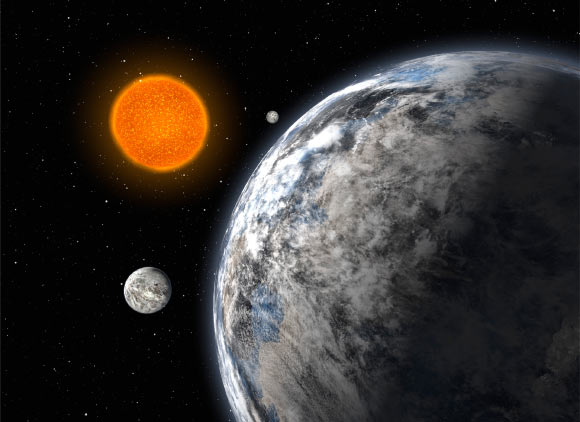Astronomers using data from the NASA Kepler spacecraft’s reborn K2 mission have found a triple system of super-Earth exoplanets around a cool star called LP 415-17.
LP 415-17, also known as EPIC 210897587 and 2MASS 04215245+2121131, is a mid-late type K-dwarf star located approximately 267 light-years from Earth.
The star has a radius about 58% that of our Sun, a mass 65% that of the Sun, and is home to at least three massive planets: LP 415-17b, c and d.
The planets were detected through the transit method — which measures dips in the amount of light from the star as a planet ‘transits,’ passes in front of it — by NASA’s extended Kepler exoplanet-hunting mission, known as K2.
Dr. Francisco Javier de Cos Juez from the University of Oviedo and colleagues relied on data from K2’s Campaign 13 (took place between March 08th and May 27th, 2017) to determine the sizes, masses and orbits of these planets.

The type K-dwarf star LP415-17 (center). Image credit: Centre de Données astronomiques de Strasbourg / SIMBAD / DSS.
LP 415-17b, c and d have radii 1.8, 2.6 and 1.9 times that of Earth, respectively, and orbit their parent star with periods of 6.34, 13.85 and 40.72 days.
The orbit of the furthest planet — LP 415-17d — has radius of 0.18 AU, close to the inner edge of the habitable zone.
According to the team, the LP 415-17 system is a good observational target for future facilities such as the NASA/ESA/CSA James Webb Space Telescope.
“This system is suitable to improve our understanding of formation and dynamical evolution of super-Earth systems in the rocky-gaseous threshold, their atmospheres, internal structure, composition and interactions with host stars,” Dr. de Cos Juez and co-authors said.
A paper describing the discovery will be published in the Monthly Notices of the Royal Astronomical Society (arXiv.org preprint).
Source: Sci News

































Leave a Comment
You must be logged in to post a comment.